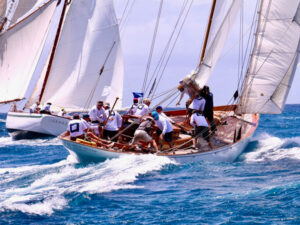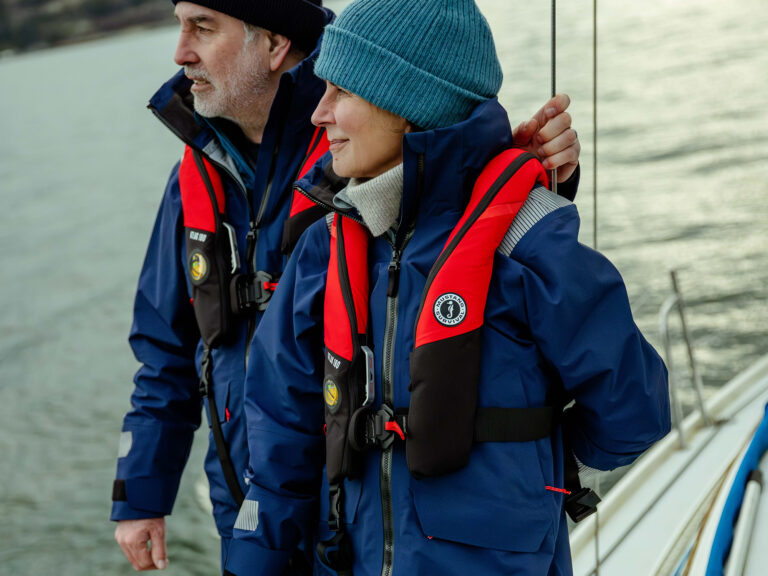
Not you too, Son,” my father said sadly.
It was the late 1950s, and the crew of the schooner Elizabeth, wearing rags, were lined up for a dressing down on the foredeck. We’d been heading into a setting sun in the Florida Keys and had run hard aground on a shoal. We’d then attempted to kedge off—with a large anchor, a clinker-built rowing dinghy named Lil’ Liz, and a stiff, tarred-hemp anchor rode that handled like unruly razor blades.
Father wasn’t happy. Our schooner had a 52-foot length on deck and a 64-foot length overall. This Alden-designed schooner weighed three times more than a modern vessel. She drew 8½ feet. Her iron keel was long and narrow. Our anchor windlass was manual and inefficient. Darkness was only two hours away. A northerner was coming. There were building swells too.
All of this was bad, but what happened next was far worse. Carole, my oldest sister, made a sound. It was kind of a yelp but strangled in mid-cry. All of us became wide-eyed at her insolence until Mother, aka the Sea Siren, began to laugh. Gale, the middle child, also began to giggle, chuckle, and then outright hoot and guffaw. Jerry, our ship’s dog, let go a howl or two to show her solidarity with the sisterhood.
I’m loath to point out the petty sexism of male sailors back in the day, but all this made unfortunate sense to my provincial father. To him, women were the weaker sex. This was an emergency. They should be dutifully following orders, not giggling or openly mocking their captain.
I, a mere lad of 8 years, stood off to the side, leaning toward my beloved father’s view. But then, for an instant, I saw the absurdity of what was happening—a sun-bronzed, freedom-crazed skipper dressed in a Tahitian pareo aboard a dilapidated schooner that had somehow sailed out of the 1920s was yelling at his cowering family because he’d failed to have the sun over his shoulder as he entered a tropical port.
I realized that nothing can turn an easygoing man into a drill sergeant faster than a tiller in his hand. And that was when I too allowed a giggle of amusement to escape, causing my betrayed father to utter those fateful words: “Not you too, Son.”
Yes, we learn as we sail. I’ve sailed a lot, so I can claim—however falsely—to have learned a bit. This little episode taught me that, on any pleasure cruise, there’s the skipper who sweats the details and a crew who doesn’t—nor should they be asked to. If you assume the mantle of captain, you have to accept the responsibility and the realization that your guests shouldn’t (and can’t, really) share the burden.
Let’s back up a tad. I’ve been scribbling about boats for 50 years now. I’ve written a lot of how-to articles. This column, though, is about how not to. Put another way, it’s about where I fall short as skipper.
One place where I fall short is failing to appreciate the shore-centric reality of my guests. For instance, we were in Vava’u, Tonga, and sailing to the capital city of Nukualofa, where our San Francisco guest would fly out the next day. This was an adult who had traveled the world on land, graduated from an Ivy League university, and had the smarts to buy Apple stock when Jobs and Woz were still in the garage.
Everything was fine. It was a perfect sailing day in paradise. Ganesh, our 43-foot ketch, was rail-down and broad-reaching in 24 knots of breeze. The water was gin-clear. The verdant islands slid by like a Winslow Homer watercolor.
Our guest was utterly beguiled by our lifestyle for more than an hour. Our decks were dry. Everything was going fine until our guest awoke after a nap, looked around, blinked, looked around frantically, and then began to cry aloud.
I’m not talking about a whimper. I’m talking about a full-on I-don’t-want-to-die scream. “Oh, my God! Where’s land? Point to land! Oh, God! Take me back! Take me back to land right now!”
I was not terribly compassionate.
“What?” I sneered. “You didn’t realize that islands 40 nautical miles apart had water in between? Or that from the deck of a small vessel, you can’t see too far?”
My wife, Carolyn, cautioned, “Berating a blubbering lubber who may have just been mentally scarred forever and consequentially sentenced to therapy for the rest of their natural life isn’t going to help.”
The truth is, I’m sea-centric. I view the world through the keyhole of a sailor, not a rock-hugger. I remember being in a severe Pacific gale with Mexico on my lee. While I desperately attempted to claw off the coast to get sea room, that guest asked me without guile, “Think we can make it into safe harbor before the worst of it?”
Land is the danger, I thought, not the solution.
I’ve spent decades in the Caribbean. A guest once asked me, while transiting the incredibly deep Puerto Rican trench, if we were going to anchor after dark so that we could get some sleep.
“How much scope do you think that requires?” I mused. “Thirty-thousand feet times five?”
Having headquartered out of St. John in the US Virgin Islands for two decades, I can’t tell you the number of times I’ve been asked if the islands go “all the way to the bottom.”
“Nah,” I always say. “They just drift around, which isn’t a problem unless they bump into each other, which is probably what sank Atlantis.”
Yes, numerous charter guests have brought tiny vials with them to collect samples of “all the different colors of the seawater.”
We’re currently on our fourth circumnavigation. While we have friends who have completed the Big Fat Circle in a quick two years, we usually take five to seven years, while enduring dock lizards who constantly ask us, “How many days does it take to sail around the world?”
What, they’ve never spun a globe? Never compared the speed of a modern jet in relationship to a half-tide rock such as Ganesh?
Yes, dirt-dwellers are set in their ways. The last time we were in Thailand, I was forced to shut off our water-pressure pump because a stubborn guest insisted on run-run-running his shower. The result wasn’t me being mad at him as much as him being mad at me. “Come on, Fatty,” the fellow said. “This is 2020, not the 1600s.”
Yes, as expected, he was a tad busy sightseeing when we repeatedly ferried out the jugs to refill our 80-gallon tanks. (Occasionally, our 3-gallon-per-hour desalination unit works, but only if we can afford the amperage.)
But speaking of electrical issues, I was between Bermuda and St. Maarten when a guest came into the cockpit with a hair dryer and asked where they could plug it in.
“Puerto Rico?” I replied. “St. Barts, maybe? Argentina?”
The same answer applies to the question, “Where is the shower’s hot-water valve?”
Of course, during the first few decades of my offshore career, we used celestial navigation. When asked if I knew our location as we cruised the Caribbean in the 1970s, I could honestly reply: “Sure. South of North America and north of South America.”
Oh, those were good ol’ days. You could tell folks on St. Thomas that you got there by sailing south until the butter melted, then banged a left.
Seriously, I used to clear Sandy Hook and square away to a point well west of Bermuda, then run down my latitude with noon sights (which didn’t require accurate time) and finally turn to port. Just to be sure, I’d switch on a transistor radio. If the AM signal got louder, I was dead-on course.
Easy-peasy, right? Why make it difficult?
In the 1970s, I had a Bulova Accutron wristwatch with a tuning fork. I could walk aboard any vessel with my sextant in one hand and with my HO publications and nautical almanac in the other, and I could guide that vessel anywhere on the planet. If I wanted a big tip at the end, I’d leave sheets of paper around, filled with scribbled equations to “figure out the continental drift,” I’d say mystically.
Oh, there are lots of little tricks to make life easier offshore. In late December, it can be extremely difficult to beat 2,000 miles against the reinforced trade winds from Florida to the Lesser Antilles. The seas are large. Falling into the troughs is like hitting concrete. And this boat-jarring crash doesn’t happen one time, but rather a million times. The results are predictable.
Thus, whenever the bilge of a vessel that I was sailing eastward across the Thorny Path would suddenly fill with water, I’d just dip and taste my finger, and then smile while the rest of the crew tried to find the leak instead of checking out the ill-chocked, split-open white plastic freshwater tank under the V-berth.
I know, cruel.
Often, of course, I’d just be delivery crew. Once, off Bermuda on a custom Little Harbor 83, the skipper came up to relieve me just before dawn. I noticed that his clothes were inside out. He’d dressed in a dark cabin and hadn’t wanted to turn on a light to disturb his sleeping wife. Knowing that a captain is always right, I quietly informed the crew. It wasn’t until lunch that it slowly dawned on the poor fellow why his entire grinning crew had their clothes on inside out.
Then there were the liveaboard parents of a girl. They couldn’t refuse her anything, not even a small aquarium, which they wedged into a bookshelf while offshore. Alas, in the Indian Ocean, they got into a gale that pounded their three-masted sailboat. One wave struck them so hard that the aquarium was dislodged above the sleeping mother. She was doused with salt water, sand, small rocks and a couple of flopping fish. She screamed at her husband, “Honey, we’re aground!”
On a similar note, I installed a burglar and bilge alarm on my Endurance 35, Carlotta, when I built her from scratch in Boston in 1971. This fire bell was super-noisy. Carolyn’s sister and her boyfriend flew in from Chicago to visit us in Bequia, and I soon had them offshore in heavy weather. It was rough. The motion of the seas was so violent that the boyfriend chose to sleep on the cabin sole between my wife’s bunk and mine, to prevent him from being thrown around the main cabin.
Somehow, around midnight, Carlotta hit a pothole (an empty space between waves). Our bow plunged, and the force of the crash bounced our bilge alarm on.
I’d never heard the alarm under battle conditions, and was sure our hull had broken open like an egg after being struck by a rogue wave. I jumped out of my bunk and was horrified to discover in my grogginess that not only were we sinking, but also that the hole in the hull was so freaking big that I was standing on the back of whale.
The boyfriend’s point of view was a tad different.
“There I was, scared out of my mind offshore, when a loud noise went off—so loud and so terrifying that I couldn’t think straight,” he recalled. “It was pitch-black inside the swaying cabin, and all my rationality had fled. Next thing I knew, 175 pounds jumped on my stomach, whooshing the air completely out of my chest. Before I could manage to suck back in any oxygen, a bare foot jammed down my exposed neck, cutting off my air supply and preventing me from breathing in. As I began to black out and see the approaching white light, my only thought was that I was certainly hearing the last bell, for sure.”
He never visited again. Last we heard, he’d purchased rural property in Indiana and puked each time he saw a picture of a seascape.
I know, I know. I should have more compassion, right?
And this isn’t mentioning Joker, our cat, whose favorite thing during night crossings of the Anegada Passage was to catch flying fish on the foredeck and then proudly deposit them (wet, alive and wiggling) onto the chests of our sleeping guests below.
Oh, the screams as they levitated.
All of which is why Carolyn often slaps her forehead as she informs our guests, grimly, “I’ve made only two mistakes in life: Saying ‘I’ and ‘do’ were both of ’em.”








